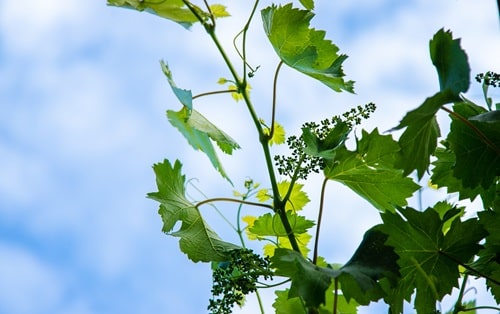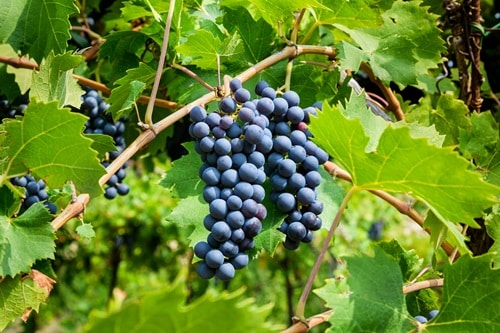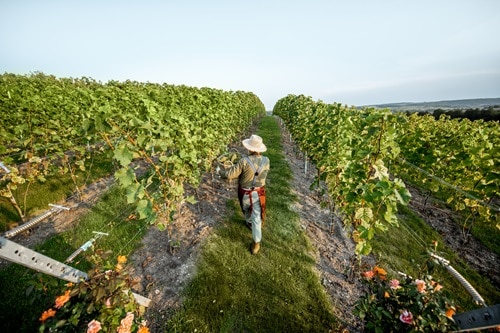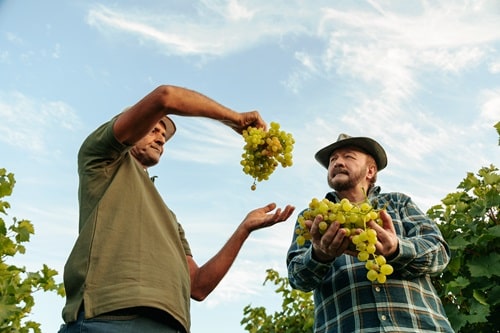The vine or Vitis vinifera is a member of the Vitaceae family, originally from Asia. It has survived the ages, diversifying into a multitude of varieties cultivated today throughout the world, notably in France.
Different grape varieties, such as Cabernet Sauvignon and Merlot for red wines, and Chardonnay and Sauvignon Blanc for white wines, are selected to personalize the wine’s aromas and textures. Each grape variety has its own identity, adapted to specific climates and soils, enabling winemakers to personalize their wines, catering to the varied tastes of wine lovers.
Vine plants can produce grapes of various colors, from white to black, which influence the color and taste of the wine produced. This variety of colors results from the careful selection of vine plants, with the aim of producing grapes that meet not only color requirements, but also the taste expectations of consumers. Choosing which vines to grow is a strategic decision for any winegrower. By taking into account the specific characteristics of each variety, climatic conditions and disease risks, you can optimize your production and ensure the long-term future of your vineyard.
Selection of grape varieties by fruiting period

We recommend that you choose your vineyard according to fruiting periods to optimize the harvest and enjoy the pleasures of the grape.
With three key ripening periods for grape varieties: early, seasonal and late, it’s possible to personalize your garden or vineyard for spread-out, variety-rich production.
These hardy, climbing plants offer a diversity of fruits in a variety of colors, tastes and textures, from pink and golden grapes to thick skins and juicy flesh, suitable for both table consumption and the production of fine wines.
Early variety
For harvesting as early as July, early grape varieties such as Chasselas Rose, Chasselas doré and Cardinal should be prioritized. Their early ripening means you can get ahead of late-season diseases and enjoy the first fruits of summer.
Seasonal grape variety
Between August and September, seasonal grape varieties such as Muscat de Hambourg, ampelia Aladin and ampelia Candin ripen and offer generous clusters perfect for wine or table. These varieties, with their distinctive taste and succulent flesh, are an ideal choice for those looking to personalize their harvest with top-quality grapes that balance sugar and acidity.
Late grape variety
To prolong the pleasure until the first frosts of October, late-ripening grape varieties such as Italia and Chardonnay are a must. Resistant and robust, these grape varieties benefit from a long ripening period. Their adaptation to climatic variations makes them excellent choices for regions with more marked seasons.
Vine types according to climate
When selecting your grape varieties, you need to take into account their resistance to cold if you live in a region with harsh winters, or choose varieties adapted to heat and drought for areas with milder climates, such as the Midi.
For regions with cold winters
In regions prone to cold winters, you need to choose grape varieties that are resistant to low temperatures and able to survive late frosts. Varieties such as Chardonnay and Pinot Noir, with their good resistance to cold and ability to ripen quickly, are wise choices.

For regions with a mild southern climate
In regions with a milder climate, such as the South of France, vines have to adapt to summer heat and drought. Varieties such as Grenache, Syrah and Muscat excel in these conditions, producing grapes that ripen well in the generous sunshine to produce robust red wines and aromatic white wines. These varieties, with their thick skins and juicy flesh, are ideal for both table wines and winemaking, offering a rich and varied palette of tastes.
How do you get a good crop of grapes?

Getting a good crop of grapes requires care and attention. Here are a few tips for successfully cultivating your vines and maximizing the potential of every bunch.
Soil and root management
Vines thrive in well-drained soils rich in nutrients and minerals. A soil analysis can help you identify the amendments needed to optimize growth.
Analyze your soil’s fertility by measuring, for example, its nutrient content, pH, structure, texture and water retention capacity.
This will enable you to understand your soil’s needs and adjust its management, such as adding organic or mineral amendments to balance the pH or enrich the soil for deficient nutrients. Grafting vines onto resistant roots can also improve plant vigour and resistance to disease and environmental stress.
Pruning and care
Pruning is crucial for controlling growth and ensuring good aeration of bunches, thus reducing the risk of disease. It also enables the plant to concentrate its energy on producing quality fruit. Pruning must be adapted to the type of vine and the production objective (table grapes or wine).
When winter arrives, the risk of frost is high, and can damage buds and young shoots. To ensure the longevity of your vineyards and protect your vines against frost, theuse of an anti-freeze tower can be strategic. Designed to mix layers of cold air on the ground with layers of warmer air at higher altitudes, the tower raises the temperature around the vines.
Protection against disease
Vines are prone to various diseases, such as powdery mildew and downy mildew. Regular monitoring and the application of preventive or organic treatments can help keep your plants healthy. Choose disease-resistant varieties to reduce dependence on chemical treatments and promote a more sustainable approach.
Irrigation and nutrition
Although hardy, vines benefit from controlled irrigation and balanced nutrient inputs, especially in drier regions or during periods of prolonged drought. Drip irrigation is an effective method of delivering water directly to the roots, minimizing wastage and reducing the risk of moisture-related diseases.
Harvest at maturity
To guarantee the quality of the final product, harvest the grapes when they are ripe. Successful harvesting depends on precisely identifying when the grapes have reached their optimum point of ripeness, taking into account vine variety, climatic conditions and the type of wine desired.
Observe the maturity of bunches
Grape ripeness depends on a number of factors, including color, taste and texture of the skin and flesh. White grapes, for example, turn from green to golden yellow, while red and black varieties develop a deep, uniform color.

We recommend tasting the berries, as a perfect balance of sugar and acidity generally indicates that the grapes are ready. In addition, the ease with which the seeds detach from the flesh can be an indicator of ripeness.
Take climatic conditions into account
The weather plays a crucial role in the timing of the harvest. Ideally, grapes are picked in dry weather, to reduce the risk of rot and dilution of flavors. An early morning harvest is often preferable, to take advantage of freshness and preserve the grapes’ delicate aromas.

